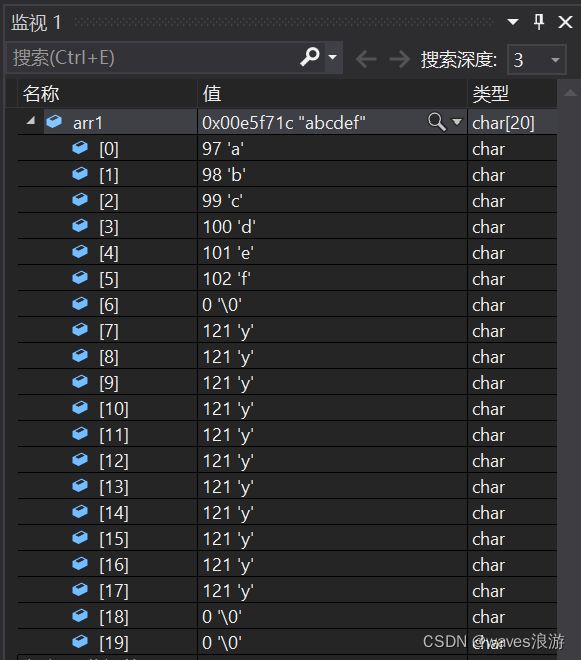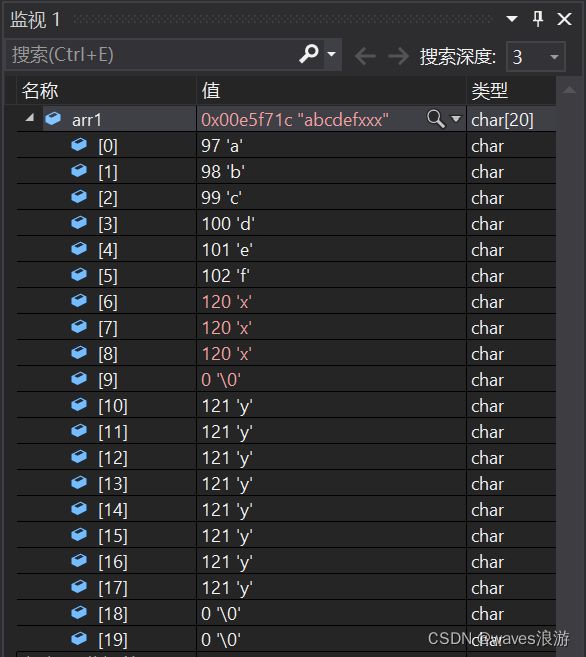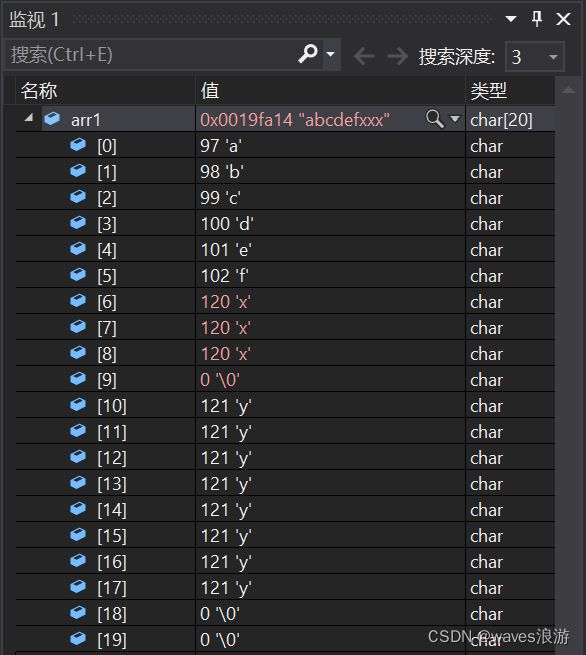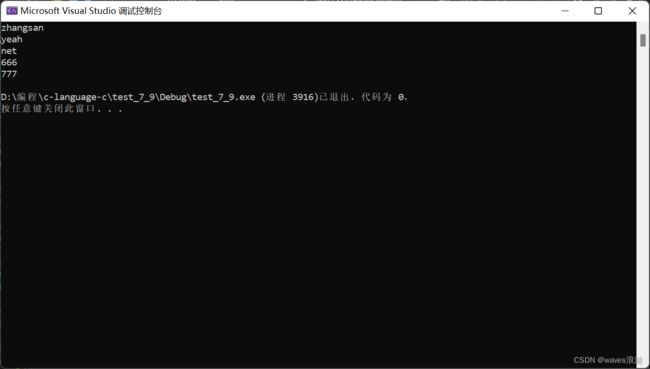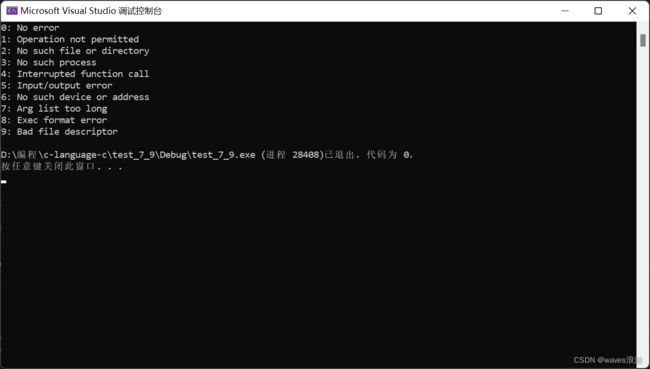字符串和内存函数(1)
文章目录
- 目录
-
- 1. 前言
- 2. 函数介绍
-
- 2.1 strlen
- 2.2 strcpy
- 2.3 strcat
- 2.4 strcmp
- 2.5 strncpy
- 2.6 strncat
- 2.7 strncmp
- 2.8 strstr
- 2.9 strtok
- 2.10 strerror
- 2.11 字符分类函数
- 2.12 字符转换函数
目录
- 求字符串长度函数
- 长度不受限制的字符串函数
- 长度受限制的字符串函数
- 字符串查找函数
- 错误信息报告函数
- 字符操作函数
- 内存操作函数
1. 前言
C语言中对字符和字符串的处理很是频繁,但是C语言本身是没有字符串类型的,字符串通常放在常量字符串或者字符数组中;字符串常量适用于那些对它不做修改的字符串函数。
2. 函数介绍
2.1 strlen
size_t strlen(const char* str);
- 字符串以 ‘\0’ 作为结束标志,strlen函数返回的是在字符串中 ‘\0’ 前面出现的字符个数(不包含 ‘\0’)。
- 参数指向的字符串必须要以 ‘\0’ 结束。
- 注意函数的返回值为size_t,是无符号的。(易错)
#include 以上代码的结果是大于,这就是因为strlen返回的是无符号的整型,所以应该这样写:
#include #include 以上两个代码的结果就是小于等于。
我们再来复习一下strlen函数的模拟实现:
#include 另外两种方法如果不清楚,可以看之前的指针初阶(1)。
2.2 strcpy
char* strcpy(char* destination, const char* source);
- Copies the C string pointed by source into the array pointed by destination, including the terminating null character (and stopping at that point).
- 源字符串必须以 ‘\0’ 结束。
- 会将源字符串中的 ‘\0’ 拷贝到目标空间。
- 目标空间必须足够大,以确保能存放源字符串。
- 目标空间必须可变。
#include 我们再来看一下strcpy函数的模拟实现:
#include 2.3 strcat
char* strcat(char* destination, const char* source);
- Appends a copy of the source string to the destination string. The terminating null character in destination is overwritten by the first character of source, and a null-character is included at the end of the new string formed by the concatenation of both in destination.
- 源字符串必须以 ‘\0’ 结束。
- 目标字符串也必须以 ‘\0’ 结束。
- 目标空间必须有足够的大,能容纳下源字符串的内容。
- 目标空间必须可修改。
#include 以下是对strcat函数的模拟实现:
#include 我们思考一个问题:字符串能自己给自己追加吗?
答:strcat 最好不要自己给自己追加!
#include 
dest 和 src 中一开始存的都是 ‘h’ 的地址,之后 dest 会找到 ‘\0’ 的地址,接着通过 *dest = *src,把 ‘\0’ 替换成 ‘h’,但是这样之后 src 就找不到 ‘\0’ 了,就会进入死循环。因此,strcat 最好不要自己给自己追加!
2.4 strcmp
int strcmp(const char* str1, const char* str2);
- This function starts comparing the first character of each string. If they are equal to each other, it continues with the following pairs until the characters differ or until a terminating null-character is reached.
- 标准规定:
- 第一个字符串大于第二个字符串,则返回大于0的数字
- 第一个字符串等于第二个字符串,则返回0
- 第一个字符串小于第二个字符串,则返回小于0的数字
//VS
//> 1
//= 0
//< -1
#include strcmp的模拟实现:
#include 2.5 strncpy
char* strncpy(char* destination, const char* source, size_t num);
- Copies the first num characters of source to destination. If the end of the source C string (which is signaled by a null-character) is found before num characters have been copied,destination is padded with zeros until a total of num characters have been written to it.
- 拷贝num个字符从源字符串到目标空间。
- 如果源字符串的长度小于num,则拷贝完源字符串之后,在目标的后边追加0,直到num个。
#include 2.6 strncat
char* strncat(char* destination, const char* source, size_t num);
- Appends the first num characters of source to destination, plus a terminating null-character.
- If the length of the C string in source is less than num, only the content up to the terminating null-character is copied.
#include #include 2.7 strncmp
int strncmp(const char* str1, const char* str2, size_t num);
- 比较到出现另个字符不一样或者一个字符串结束或者num个字符全部比较完。
#include 2.8 strstr
char* strstr(const char* str1, const char* str2);
- Returns a pointer to the first occurrence of str2 in str1, or a null pointer if str2 is not part of str1.
//strstr - 字符串中找子字符串
#include #include strstr函数的模拟实现:
#include 2.9 strtok
char* strtok(char* str, const char* sep);
- sep参数是个字符串,定义了用作分隔符的字符集合。
- 第一个参数指定一个字符串,它包含了0个或者多个由sep字符串中一个或者多个分隔符分割的标记。
- strtok函数找到str中的下一个标记,并将其用 ‘\0’ 结尾,返回一个指向这个标记的指针。(注:strtok函数会改变被操作的字符串,所以在使用strtok函数切分的字符串一般都是临时拷贝的内容并且可修改。)
- strtok函数的第一个参数不为 NULL ,函数将找到str中第一个标记,strtok函数将保存它在字符串中的位置。
- strtok函数的第一个参数为 NULL ,函数将在同一个字符串中被保存的位置开始,查找下一个标记。
- 如果字符串中不存在更多的标记,则返回 NULL 指针。
#include 但是如果我们不知道它被分成了几段,那么我们应该怎么把它们全部打印出来呢?
#include 2.10 strerror
char* strerror(int errnum);
- 返回错误码所对应的错误信息。
- 库函数在执行的时候,发生了错误,会将一个错误码存放在errno这个变量中,errno是C语言提供的一个全局变量
#include #include 还有一个函数可以直接就把错误信息打印出来:
#include 2.11 字符分类函数

注:
ASCII码表中0~31是不可打印字符,其他是可打印字符。
#include 2.12 字符转换函数
int tolower(int c);
int toupper(int c);
#include 最后,我们来看一道题目:
//将字符串中的内容全部改成小写
#include 
